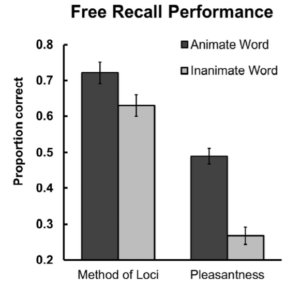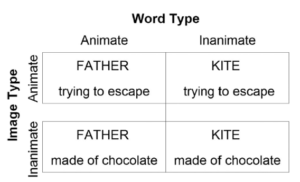Around this time of year, when the weather is cooling and the leaves are turning, I love to snuggle up on the couch and watch a good crime mystery! One of my absolute favorite shows is BBC’s, Sherlock, a television crime drama based on Sir Arthur Conan Doyle’s Sherlock Holmes detective stories. The show stars Benedict Cumberbatch as Sherlock Holmes (hands down my favorite Sherlock, no offense Robert Downing Jr.) and is absolutely brilliant. As a memory researcher, one of my favorite things about the show is its frequent references to an ancient mnemonic technique: the method of loci (a.k.a. mind or memory palace).
The method of loci is an elaborate encoding technique that provides a highly regularized retrieval environment. The method requires that individuals imagine walking through a familiar place that preferably has different rooms or distinct locations. As they walk through, they place to-be-remembered items at different locations along the route. At retrieval, they imagine retracing their steps along that route, triggering recall of the items placed at each location.
Here’s a clip of Dr. Watson describing the method of loci (memory palace).
Watching Sherlock take frequent visits to his memory palace highlights an important question of memory: how does the method of loci interact with other well known memory phenomena and encoding techniques?
In a recent article published in the Psychonomic Society journal, Memory & Cognition, researchers Janell Blunt and Joshua VanArsdall (pictured below) sought to address this very question.

In two experiments, they explore:
- How the method of loci interacts with the well-known animacy effect. The animacy effect refers to the finding of better memory for words representing animate concepts, like dogs and people, compared to inanimate concepts, like chairs and pencils.
- How the animacy effect is impacted by the method of loci compared to other encoding techniques, like pleasantness rating. Pleasantness rating is a technique that enhances encoding by calling attention to an item’s unique features. Considering an item’s features is thought to create a more elaborate memory trace for that item which, in turn, leads to better memory. While pleasantness has been shown to improve memory, it doesn’t require the use of imagery like the method of loci.
- How different aspects of animacy contribute to the animacy effect, such as the ability of a word concept to animate (e.g., dogs can run) or imagining an object (animate or otherwise) animating (e.g., imagining a dog or a pencil moving).
In Experiment 1, participants were split into two conditions (the method of loci condition and the pleasantness ratings condition) and were given a list of words to study and then recall. Half of the words on the list were animate (e.g., father) and the remaining half were inanimate (e.g., a pencil).
In the method of loci condition, participants were given instructions for encoding the study words as outlined by the method. Specifically, they learned the word lists by imagining placing study items along a familiar path, such as their childhood home. Then at test, participants were asked to mentally retrace their steps along the familiar path to recall the items that were “placed” in each location.
In the pleasantness ratings condition, participants were asked to rate how pleasant each word was using a 5-point ratings scale. After the last word was rated, participants were given a free recall test.
The results were interesting (see figure below and to the right). First, researchers found better recall performance in the method of loci condition compared to the pleasantness ratings condition. In addition, animate words were recalled more frequently than inanimate words. However, the animacy effect (i.e., better memory for animate words) was smaller in the method of loci condition than in the pleasantness ratings condition.

The authors suggest that this difference in effect size is likely due to the imagery component in the method of loci. Lastly, participants in the method of loci condition were more likely to recall words in the correct order in which they were studied, compared to participants in the pleasantness ratings condition. This finding was likely due to the fact that participants were asked to retrace their steps, retrieving items in the order in which they were placed in their “memory palace.”
In a follow-up experiment, the authors further probed the nature of the animacy effect. Specifically, they examined the relationship between animacy and imagery. In their study, a specific item could be characterized in one of four ways (see figure below and to the left for examples):

- An item can have the ability to animate or move and be mentally pictured as moving
- An item can have the ability to animate, but not be pictured as moving
- An item can lack the ability to animate on its own, but be mentally pictured as moving
- An item can lack the ability to animate on its own and not be mentally pictured as moving
To assess how these four animacy/animate imagery conditions impact memory, the authors replicated the method of loci condition from Experiment 1. However, instead of only allowing participants to generate their own imagery, in Experiment 2, participants were given a word and a description of how to imagine the word (as animate or inanimate).
 The authors found that animate words and words that were paired with animate imagery were better recalled than inanimate words and words paired with inanimate imagery (see figure to the right).
The authors found that animate words and words that were paired with animate imagery were better recalled than inanimate words and words paired with inanimate imagery (see figure to the right).
Together, this set of results suggests that animacy and the method of loci produce additive benefits to memory. Also, both aspects of animacy, the animate nature of a study item and imagining an item animating, contribute to the animacy memory boost.
So in a message to my favorite crime sleuth on 221 Baker St.: if you combine your memory palace with animacy (including animate concepts and animate imagery), then bad guys like James Moriarty won’t stand a chance!
Featured Psychonomic Society article:
Blunt, J.R. & VanArsdall, J.E. (2021). Animacy and animate imagery improve retention in the method of loci among novice users. Memory & Cognition, DOI 10.3758/s13421-021-0117-0.
